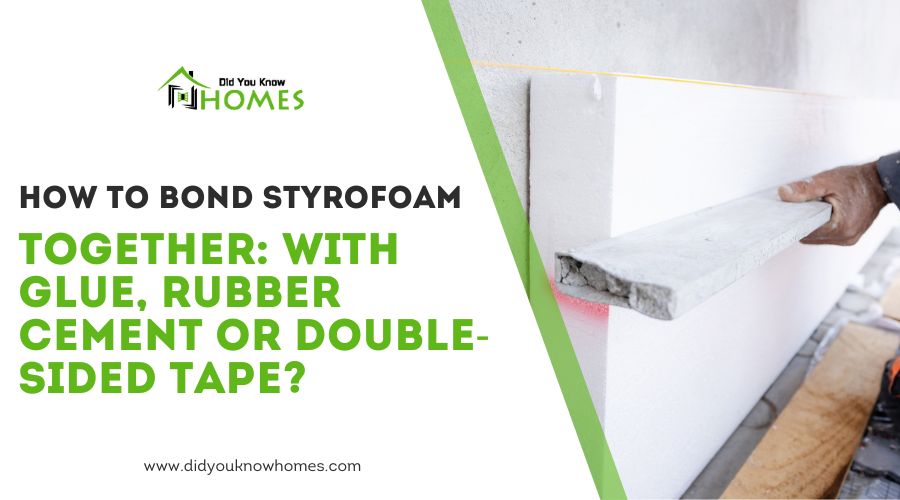Styrofoam, with its lightweight and versatile nature, is a popular material for a wide range of projects, from craft creations to insulation in construction. However, one challenge that often arises is finding the best way to bond pieces of Styrofoam together securely and effectively. While it might seem straightforward, not all adhesives are suitable for Styrofoam, as some can damage the material. This article will guide you through the process of bonding Styrofoam using three different adhesives: glue, rubber cement, and double-sided tape.
Where to Use Styrofoam
Styrofoam, a trademarked form of polystyrene foam, is a material known for its lightweight, insulating properties and versatility. It’s used in a variety of applications, each taking advantage of its unique features. Here’s a closer look at some of the most common uses of Styrofoam.
Packaging Solutions
One of the most recognized uses of Styrofoam is in packaging. Its ability to absorb shocks and insulate products from temperature changes makes it an ideal material for protecting electronics, fragile items, and perishable goods during shipping. Styrofoam packaging comes in various forms, including molded shapes that snugly fit around items, ensuring they remain secure in transit.
Building and Construction
Styrofoam plays a crucial role in the building and construction industry. It serves as an excellent insulator, helping to reduce energy costs and improve the energy efficiency of homes and buildings. Styrofoam insulation is commonly used in walls, roofs, and foundations due to its resistance to moisture, which prevents mold and mildew growth. Moreover, it’s lightweight, making it easy to handle and install.
Crafts and Decorations
The lightweight and easy-to-cut nature of Styrofoam makes it a favorite among crafters and artists. It serves as a versatile base for models, sculptures, and decorative items. Whether it’s for a school project or a professional art piece, Styrofoam can be shaped, painted, and decorated in countless ways to bring creative ideas to life.
Each of these uses highlights Styrofoam’s adaptability and effectiveness in various fields. Its properties offer solutions to common problems, from reducing shipping damage to enhancing building energy efficiency.
Bonding Styrofoam: Glue, Rubber Cement, and Double-Sided Tape
When it comes to bonding Styrofoam, there are several options available, each with its unique set of advantages and drawbacks. Understanding these can help you choose the best method for your project, whether you’re working on a craft, model, or insulation. Here’s a look at three popular choices: glue, rubber cement, and double-sided tape.
Glue
Pros: Glue designed for Styrofoam is effective and creates a strong bond, making it a reliable choice for durable projects. It’s versatile, allowing for its use in a wide range of applications, from crafts to construction. The ease of application is another benefit, as it requires minimal preparation and tools.
Cons: Not all glues are suitable for Styrofoam; some can melt the foam or weaken the bond. It’s crucial to choose the right type, and even then, drying times can be long, requiring clamps or weights to hold pieces in place.
Rubber Cement
Pros: Rubber cement is great for temporary bonds or projects where a little flexibility is needed. It applies smoothly and can be repositioned in the early stages of drying, offering a bit of wiggle room for adjustments.
Cons: The bond created by rubber cement is not as strong as that of some glues specifically designed for Styrofoam. It’s also flammable and emits strong fumes, requiring good ventilation during use. Over time, rubber cement may become brittle, losing its adhesive properties.
Double-Sided Tape
Pros: Double-sided tape offers a clean, quick, and easy way to bond Styrofoam without the mess or drying time of liquid adhesives. It’s perfect for lightweight applications and temporary setups, providing immediate adhesion.
Cons: The bond strength is generally lower compared to glue and may not withstand stress or weight. Additionally, the adhesive on the tape might not perform well under extreme temperatures or in outdoor conditions, limiting its use in certain projects.
Conclusion
Whether you opt for glue, rubber cement, or double-sided tape, the key lies in matching your choice to the specifics of your task at hand. Glue stands out for its strength and versatility, rubber cement for its flexibility and ease of repositioning, while double-sided tape offers a mess-free and immediate solution. By considering the pros and cons of each method, you can ensure a successful bond that meets your needs, whether for a craft, a model, or any other Styrofoam-based creation.


